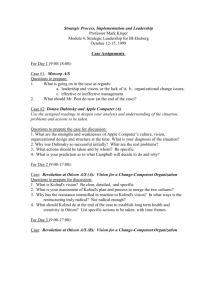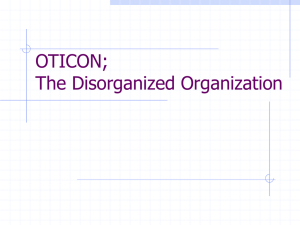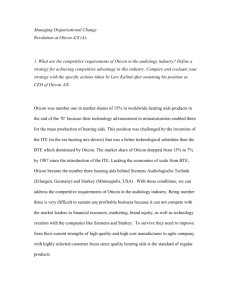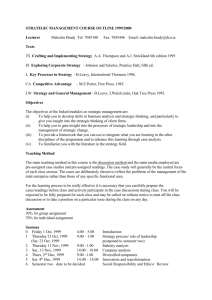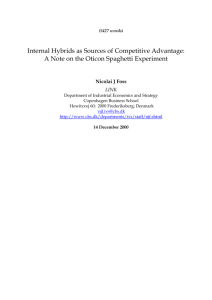Oticon Case Study
advertisement
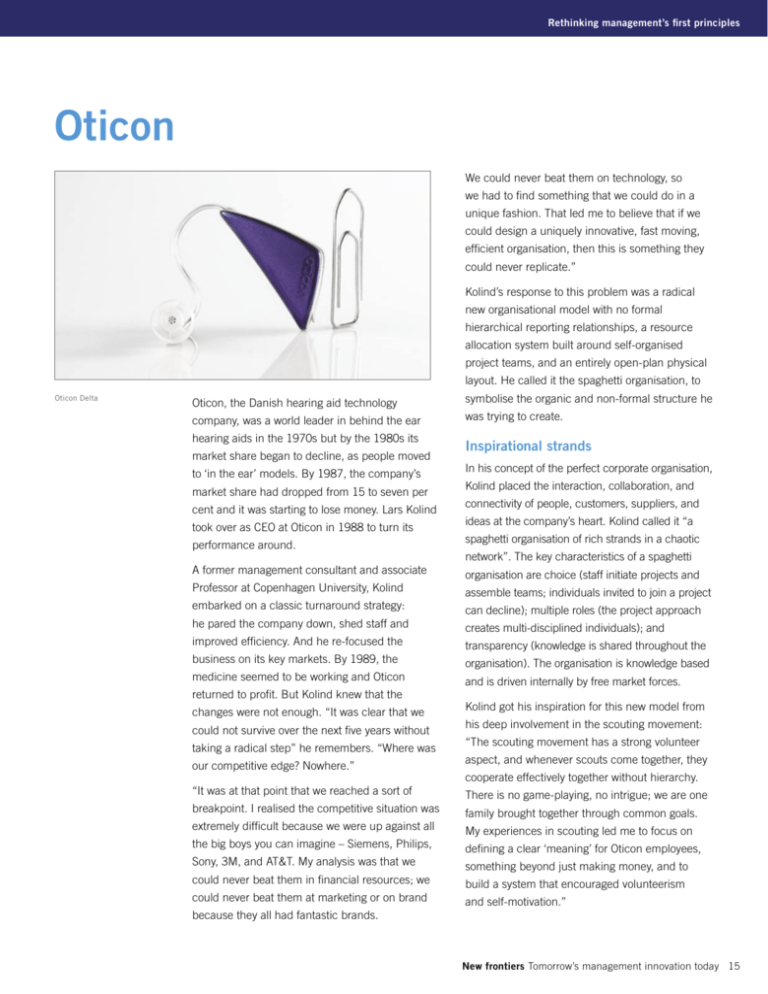
Rethinking management’s first principles Oticon We could never beat them on technology, so we had to find something that we could do in a unique fashion. That led me to believe that if we could design a uniquely innovative, fast moving, efficient organisation, then this is something they could never replicate.” Kolind’s response to this problem was a radical new organisational model with no formal hierarchical reporting relationships, a resource allocation system built around self-organised project teams, and an entirely open-plan physical layout. He called it the spaghetti organisation, to Oticon Delta Oticon, the Danish hearing aid technology symbolise the organic and non-formal structure he company, was a world leader in behind the ear was trying to create. hearing aids in the 1970s but by the 1980s its Inspirational strands market share began to decline, as people moved to ‘in the ear’ models. By 1987, the company’s market share had dropped from 15 to seven per cent and it was starting to lose money. Lars Kolind took over as CEO at Oticon in 1988 to turn its performance around. A former management consultant and associate Professor at Copenhagen University, Kolind embarked on a classic turnaround strategy: he pared the company down, shed staff and improved efficiency. And he re-focused the business on its key markets. By 1989, the medicine seemed to be working and Oticon returned to profit. But Kolind knew that the changes were not enough. “It was clear that we could not survive over the next five years without taking a radical step” he remembers. “Where was our competitive edge? Nowhere.” “It was at that point that we reached a sort of breakpoint. I realised the competitive situation was extremely difficult because we were up against all the big boys you can imagine – Siemens, Philips, Sony, 3M, and AT&T. My analysis was that we could never beat them in financial resources; we could never beat them at marketing or on brand because they all had fantastic brands. In his concept of the perfect corporate organisation, Kolind placed the interaction, collaboration, and connectivity of people, customers, suppliers, and ideas at the company’s heart. Kolind called it “a spaghetti organisation of rich strands in a chaotic network”. The key characteristics of a spaghetti organisation are choice (staff initiate projects and assemble teams; individuals invited to join a project can decline); multiple roles (the project approach creates multi-disciplined individuals); and transparency (knowledge is shared throughout the organisation). The organisation is knowledge based and is driven internally by free market forces. Kolind got his inspiration for this new model from his deep involvement in the scouting movement: “The scouting movement has a strong volunteer aspect, and whenever scouts come together, they cooperate effectively together without hierarchy. There is no game-playing, no intrigue; we are one family brought together through common goals. My experiences in scouting led me to focus on defining a clear ‘meaning’ for Oticon employees, something beyond just making money, and to build a system that encouraged volunteerism and self-motivation.” New frontiers Tomorrow’s management innovation today 15 Rethinking management’s first principles > Oticon “I was inspired by frustrations in former jobs”, he “My thinking went like this. If Oticon was to says, looking back. “Management seldom made compete with a serious competitor like Siemens, a positive contribution to the development of the we had to do something radically different. You business. Too much control; too little spirit, joy can’t just do it 10 percent different. You have to or inspiration.” do it radically different and use your imagination, gut feeling, whatever it is, and hope it will work. So I was aware that I couldn’t simply read the same books as the MBAs at Siemens. I had to find “I was aware that I couldn’t simply read the same books as the MBAs at Siemens. I had to find something that was unique and better.” something that was unique and better.” Kolind’s first challenge in implementing these ideas was to persuade the owners of the company (primarily a foundation) that a radical change was necessary to confront the challenge posed by its giant competitors. Once that had been achieved If scouting was the inspiration for collaboration, he embarked on a massive internal selling Kolind says there was another important inspiration programme to explain the nature of his proposed -- the desire to create a radically new physical changes to the employees. design for the Oticon workplace. “I had a vision that we would work according to a common goal, and we would empower the staff to the maximum level. I knew that management innovation was the name of the game although we didn’t use that word at that time. I knew intuitively that innovation would take place if we let people with different backgrounds work together and inspire each other; So that the engineers and the marketing people and the accountants got to inspire each other. Therefore I broke down the walls. “At this time, many companies were actually manifesto for change: it was to be nothing short of a revolution. In future, he believed a company’s success would be increasingly reliant upon creating the right working environment - one where employees behaved as individuals rather than part of a large organisation. Inevitably there were some employees who chose to leave because they were not comfortable with his changes, but most were quick to see the benefits, and became involved in implementing the transition. moving away from open plan offices. They had Spaghetti in action done open plan offices in the seventies and So how does the spaghetti organisation work? Any eighties because that was the fashion. But they individual who comes up with a good idea is free were actually moving back because they said to assemble a team and act as project leader. people were disturbing each other so much. My Each project, however, then has to compete with thinking was different. I said OK, we want the all the other projects trying to get off the ground at open office because we want everybody to disturb any time. In true Darwinian fashion, an employee each other -- with relevant input. And the way to must attract sufficient resources and support for make the input relevant is by getting people to his or her project or it will perish. move and sit together with those people that they At times, there are up to 100 projects on the go, should be disturbing. That’s why we took away the paper and established this open, flexible office. 16 On New Year’s Day 1990, he produced his forming and disbanding as tasks are started or completed. Individuals invariably contribute to Rethinking management’s first principles > Oticon more than one project at a time. Key to freeing up At that point many observers thought the the way people think and work is Oticon’s mobile revolution had gone far enough, but not Kolind. office system. Employees carry their office with By the end of 1995, he sensed that something them wherever they go at Oticon’s headquarters. wasn’t right. It had been a hard year, with Desks are not allocated; instead workers use the company almost exclusively focused on the nearest available workstation , rolling their developing and releasing a new line of digital personal Rullemaries – Rolling Marys or mobile hearing aids. The new products epitomised the carts – around the hardwood floor to wherever breakthrough culture. The problem was that the they need to be in the building. temporary teams created to push them through Each mobile cart holds up to 30 hanging folders had assumed an air of permanence. and other office paraphernalia. The caddy is The dis-organised company was becoming mounted on wheels and trundled around the dangerously organised. Kolind’s solution was to office as the employee travels from team to team “explode Oticon in a new direction”. Projects were throughout the day. re-arranged geographically within the building. He And then there’s the paperless office concept for which the company is famous. Paper is all but outlawed from the organisation. Incoming mail is scanned into the company’s computer described the result as “total chaos” – precisely what he was looking for. As he reflected: “To keep a company alive, one of the jobs of top management is to keep it disorganised.” system before being shredded. Some important When Lars Kolind stepped down from Oticon in documents – legal documents and reports, for 1998 he left it in a strong competitive position. example – may be kept for a few days or longer, And notwithstanding the inevitable changes, and but the majority of paper is shredded within hours the shift to new premises, the company stayed of arriving. loyal to the values and principles Kolind put in The shredder is connected to a transparent chute which passes through the company cafeteria directly below, allowing workers on breaks to watch a satisfying stream of falling paper on place. Oticon continues to lead the hearing aid market, with double-digit growth and industryleading returns throughout the 1990s and into the new millennium. its way to the recycling bins. Kolind estimates that the new way of working reduced circulating Resources paperwork by 80 per cent. Kolind, L. 2006. ‘The Second Cycle: Winning the war against bureaucracy’. Wharton School Publishing. Validation The new way of working seems to work. During the recession of the early 1990s, Oticon’s industry experienced some of the toughest trading conditions in its history. During those dark days, however, Oticon proved the exception to the rule. Foss, N. J. 2003. ‘Selective intervention and internal hybrids: Interpreting and learning from the rise and decline of the Oticon spaghetti organization’. Organization Science 14: 331-349. Lovas, B., & Ghoshal, S. 2000. ‘Strategy as guided evolution’. Strategic Management Journal 21: 875-896. In 1995, it published figures showing revenues of $160 million and operating profits of $20 million – an increase of 100 per cent on revenue and a ten-fold increase in profits on the figures for 1990. New frontiers Tomorrow’s management innovation today 17
